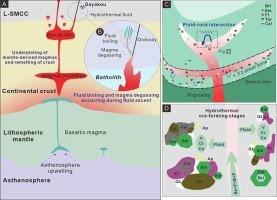Ore Geology Reviews ( IF 3.2 ) Pub Date : 2021-09-03 , DOI: 10.1016/j.oregeorev.2021.104454 Zheng-Yu Long 1 , Xiao-Yan Yu 1 , Xue Jiang 2 , Bi-Jun Guo 3 , Cheng-Yao Ma 1 , Yun You 1 , Yu-Yu Zheng 1

|
The formation of tectonic magmatic-related emerald deposits necessarily invokes a mixing model of Be-rich granitic rocks and Cr and/or V-rich surrounding rocks. However, there has been continuing debate on the deposit genesis, with the essential controversy being the relative significance of magma versus metamorphism in mineralizing as well as the key triggers for emerald deposition. The Dayakou emerald deposit genetically related to the Cretaceous granitic magmatism and hosted within the Neoproterozoic metasedimentary rocks is an ideal study case to probe into the above outstanding issue. In this paper, three hydrothermal mineralization and related alteration stages have been recognized in Dayakou, comprised of the greisenization and early emerald mineralization in high-temperature hydrothermal condition (stage-I; peak at 380 °C to 480 °C), the silicification and main emerald mineralization in medium–high temperature fluid (stage-II; peak at 300 °C to 360 °C) and the late carbonate alteration and scheelite mineralization (stage-III). Analysis results of fluid inclusion and C–H–O isotopes of emeralds and associated minerals suggest that ore-forming fluids belong to the H2O–NaCl ± CO2 system with minor H2S, CH4, and N2, exsolved from the Cretaceous granites and gradually interacted with the surrounding metamorphic rocks. We combine the new data with those reported in earlier studies to further propose a genesis scenario for the Dayakou deposit, in which Be-bearing fluids originally exsolved from peraluminous melts and fluoride complexes may be an effective transport proxy for Be in hydrothermal fluids. Fluid boiling during fluid ascent leads to the significant fractionation and enrichment of elements and the escape of volatiles (e.g., HF, H2O, CO2) in ore system. Meanwhile, sustained fluid-rock interaction (e.g., greisenization) increasingly extracts Cr, V and Ca into fluids to facilitate mineral precipitation, wherein the crystallization of fluoride minerals would cause the destabilization of Be-F complexes. Our study indicates that fluid boiling and fluid-rock interactions are the primary triggers for emerald deposition.











































 京公网安备 11010802027423号
京公网安备 11010802027423号